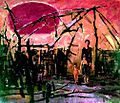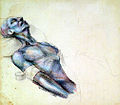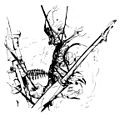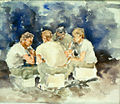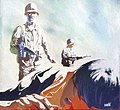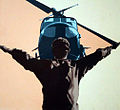| U.S. Army Vietnam Combat Artists Program | |
|---|---|
 LOOKING DOWN THE TRAIL Watercolor James Pollock, CAT IV, 1967 Courtesy of the National Museum of the U.S. Army | |
| Active | (June 1966–1970) |
| Country | United States of America |
| Allegiance | United States of America |
| Branch | United States Army |
In June 1966, the Army Vietnam Combat Artists Program was established as part of the United States Army Art Program, utilizing teams of soldier-artists to make pictorial records of U.S. Army activities in the course of the Vietnam War for the annals of military history. The concept of the Vietnam Combat Art Program had its roots in World War II when the U.S. Congress authorized the Army to use soldier-artists to record military operations in 1944. [1]
Contents
- History
- U.S. Army soldier artist participants
- Army artists after Vietnam
- Public showings
- See also
- Art Gallery (All Images Courtesy of the National Museum of the U.S. Army)
- CAT I 15 August to 15 December 1966
- CAT II 15 October 1966 to 15 February 1967
- CAT III 16 February 1967 to 17 June 1967
- CAT IV 15 August to 31 December 1967
- CAT V 1 November 1967 to 15 March 1968
- CAT VI 1 February 1968 to 15 June 1968
- CAT VII 15 August 1968 to 31 December 1968
- CAT VIII 1 February 1969 to 15 June 1969
- CAT IX 1 September 1969 to 14 January 1970
- References
- External links
During the Vietnam Era, the U.S. Army Chief of Military History asked Marian McNaughton, then Curator for the Army Art Collection, to develop a plan for a Vietnam soldier art program. The result was the creation in 1966 of the U. S. Army Vietnam Combat Art Program under the direction of the Office of Chief of Military History and McNaughton's office. Her plan included involving the U.S. Army Arts and Crafts Program, then headed by Eugenia Nowlin. McNaughton's office relied on Nowlin and her cadre of local Army Arts and Crafts directors to solicit applications from soldiers, which were forwarded to McNaughton's office at the U.S. Army Center of Military History, where selection and team assignments were made. [2] The U.S. Army provided logistics support as the teams of artists were sent to Vietnam and then to Hawaii. [3]
Artists interested in joining the program were asked to submit applications through the Army Arts and Crafts Program facilities nearest their unit. [4] Applications were to contain samples of drawings, photographs of paintings and a resume. Selections were made by a committee composed of designated representatives from the Office, Chief of Military History and the Adjutant General's Office. Supervised by Army Art Curator Marian McNaughton. [2] The program was the joint responsibility of the Office, Chief of Military History, and the Adjutant General's Office with support from the Office, Chief of information. [3]


